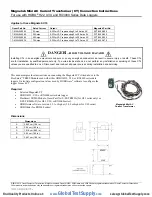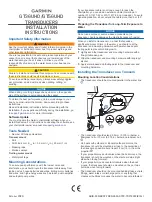
DNT500
2008 by RF Monolithics,
Inc.
7
M-0500-0000 Rev D
it checks error free. If no acknowledgment is received, the remote will retransmit the
same data on the next hop.
2.5.2 Point-to-Multipoint Network Operation
In a point-to-multipoint network, the base station is usually configured for protocol for-
matting, unless the applications running on each remote can determine the data’s destina-
tion from the data itself. Protocol formatting adds the address of the destination (remote)
and other overhead bytes to the user data. If the addressed remote is using transparent for-
matting, the destination address and the other overhead bytes are removed. If the remote
is using protocol formatting, the destination address and the other overhead bytes are out-
put with the user data.
A remote can operate in a point-to-multipoint network using either transparent or proto-
col formatting, as the base station is always the destination. In transparent operation, a
remote will add addressing, a packet sequence number and error checking bytes as in a
point-to-point network. When the base station receives the transmission, it will format the
data to its host according to its formatting configuration. A remote running in transparent
mode in a point-to-multipoint network will often have the MinPacketLength and TxTime-
out parameters set to non-zero values to reduce the chance of transmission collisions.
This is covered in more detail in section 2.6.3.
2.6 Full-Duplex Serial Data Communications
From an host application’s perspective, DNT500 serial communications appear full du-
plex. Both the base station host application and each remote host application can send
and receive serial data at the same time. At the radio level, the base station and remotes
do not actually transmit at the same time. If they did, the transmissions would collide. As
discussed earlier, the base station transmits a synchronization signal at the beginning of
each hop followed by its user data. After the base station transmission, the remotes can
transmit. Each base station and remote transmission may contain all or part of a complete
message from its host application. From an application’s perspective, the radios are
communicating in full duplex since the base station can receive data from a remote before
it completes the transmission of a message to the remote and visa versa.
2.7 Channel Access
The DNT500 provides two methods of channel access: CSMA or TDMA. Each method
supports several options as shown in the table below. The channel access setting is dis-
tributed to all remotes in the base station status packet, so changing it at the base station
sets the entire network. Carrier Sense Multiple Access (CSMA) is very effective at han-
dling packets with varying amounts of data and/or packets sent at random times from a
large number of remotes. The DNT500 includes a CSMA polling mode for coordinated
remotes and a CSMA contention mode for uncoordinated and/or reporting remotes. Time
Division Multiple Access (TDMA) provides a scheduled time slot for each remote to
transmit on each hop. The default DNT500 access mode is CSMA polling.












































